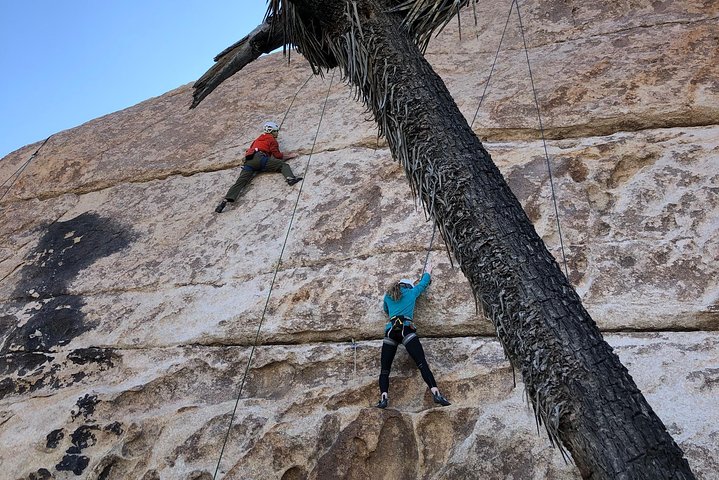Up the Granite: A Beginner’s First Climb in Joshua Tree
A four-hour, beginner-friendly ascent that teaches the ropes and introduces you to Joshua Tree’s granite playground.
The morning wind smells like sand and sage, and it moves through the grooved trunks of Joshua trees as if shrugging awake. You haul a light pack out of a guide van somewhere between Palm Springs and the park gate, pull on sneakers that feel a half-size too small, and meet a small group of strangers who will, by noon, be partners on a rope. The granite faces of Joshua Tree do not demand flashy technique; they demand attention. They wait. They test. They reward.
Trail Wisdom
Hydrate Early
Start with at least 1 liter of water and bring a second; desert air is dry and climbing increases sweat rate even in cool temps.
Shoe Choice Matters
Wear sticky-soled approach or climbing shoes if you have them; rented shoes are often limited, so bring yours if possible.
Sun Protection
Bring a brimmed hat and broad-spectrum sunscreen—the sun reflects off granite and quickly intensifies exposure.
Learn the Knots
Practice a figure-eight follow-through knot and the belay loop at home; guides will teach it but prepractice speeds learning.
Local Knowledge
Hidden Gems
- •Barker Dam pictograph sites for a quick cultural detour
- •Cap Rock at sunset for dramatic silhouettes and easier scrambling
Wildlife
Desert cottontail, Black-tailed jackrabbit
Conservation Note
Trails and climbing areas protect cryptobiotic soils and fragile desert flora; stick to established trails, pack out waste, and avoid chipping or altering rock.
Joshua Tree was designated a national park in 1994 and has a climbing legacy dating back to mid–20th century pioneers of American rock climbing.
Seasonal Guide
spring
Best for: Mild temperatures, Wildflower blooms, Longer daylight
Challenges: Crowds on weekends, Occasional wind storms
Spring is ideal for moderate temps and clear mornings, though weekends can be busy and winds can pick up in the afternoon.
summer
Best for: Late-night bouldering, Low crowds in heat of day, Extended daylight
Challenges: High daytime heat, Heat-related safety risks
Summer sees high temperatures—book early-morning slots and expect to be climbing in the coolest part of the day.
fall
Best for: Stable weather, Cool afternoons, Great visibility
Challenges: Shortening days, Popular season for guides
Fall is one of the best windows for comfort and visibility; sign up early to secure preferred times.
winter
Best for: Crisp desert mornings, Less crowding, Clear, low-humidity air
Challenges: Cold mornings, Possible closure from storms
Winters are cool and clear; daytime climbs are pleasant but bring layers for chilly starts and finishes.
Photographer's Notes
What to Bring
Approach or Climbing Shoes
Sticky soles improve footwork and confidence on friction and slab moves.
1–2 Liters WaterEssential
Hydration is critical in desert conditions and helps avoid fatigue and dizziness.
Sun Hat and SunscreenEssential
Protects from prolonged sun exposure on reflective granite surfaces.
Light Softshell or Layer
Mornings can be brisk; a layer helps while standing during instruction.
Common Questions
Do I need prior climbing experience?
No, this is a beginner program; guides teach knots, belaying, and basic movement on rock.
Is climbing gear provided?
Most operators supply harnesses, helmets, and ropes; check if climbing shoes are included or available to rent.
How fit do I need to be?
Moderate fitness is fine—participants should be comfortable with short scrambles and standing on feet for several hours.
Are kids allowed?
Age limits vary by operator; many beginner group climbs accept teens with parental consent—confirm at booking.
Do I need a park pass or permit?
A Joshua Tree park entrance fee or valid park pass is required; operators sometimes include entry but confirm before arrival.
What if the weather is bad?
Guides monitor conditions and will reschedule for high winds, lightning, or unsafe temperatures; expect flexible policies.
What to Pack
Climbing shoes or sticky-soled shoes, 1–2 liters water, sun hat and sunscreen, light layers for temperature swings
Did You Know
Joshua Tree National Park was designated a national park in 1994 after being a national monument, protecting its unique desert ecosystems.
Quick Travel Tips
Book morning slots to avoid heat, confirm shoe availability before arrival, allow 45–60 minutes driving from Palm Springs, bring cash or card for park entry if operator does not include it
Local Flavor
After a climb, head back toward Highway 62 and stop at Pappy and Harriet's in Pioneertown for a beer and live music, or grab tacos and coffee in Joshua Tree Village to decompress with fellow climbers.
Logistics Snapshot
Closest airport: Palm Springs International Airport (PSP); Typical drive to trailhead: 45–60 minutes from Palm Springs; Cell service: intermittent in park; Permits/passes: Joshua Tree National Park entrance fee required
Sustainability Note
The park’s cryptobiotic soil and rare plants are easily damaged—stay on established approaches, pack out all trash, and avoid using chalk excessively on holds.
